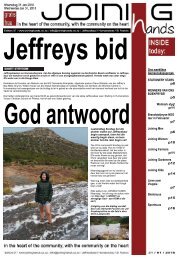Create successful ePaper yourself
Turn your PDF publications into a flip-book with our unique Google optimized e-Paper software.
March in the Garden<br />
It’s not really autumn in the garden yet,<br />
March in the garden is simply late summer<br />
with a ‘day-old beard growth’ – a lovely time<br />
of year when there is much to do and to<br />
plant in the garden…<br />
May the forest be with you!<br />
A new trend is called “forest bathing”, and<br />
on March 21, (also Human Rights Day in<br />
our country), it’s International Day of the<br />
Forests too. ‘Forest bathing’ does not entail<br />
a tiring hike through a huge plantation, and<br />
nor does it mean standing naked under a<br />
tree when it is raining, to save shower water…<br />
It means a little bit of quiet “me-time” in<br />
the company of green giants, to appreciate<br />
their huge value to our planet, and our mental<br />
health in general – being in the shade<br />
and protection of trees does seem to soothe<br />
anxiety!<br />
It is therefore important that we do not<br />
allow trees to be chopped down right, left,<br />
and centre. It’s equally important that we<br />
take time to choose the appropriate tree<br />
for different situations, (your local GCA<br />
garden centre will know!) and to support all<br />
tree-planting initiatives in our communities.<br />
Trees are the green lungs of our urban<br />
areas and planting them is a symbol of love<br />
for future generations to come.<br />
Smart planting – “The golden age”<br />
You may have seen that metallic colours<br />
like rose gold and copper are still on-trend.<br />
Metallic décor and plants with golden foliage<br />
or bright variegation is still very ‘in’ – and<br />
they create lightness and bright accents in<br />
pots or in a garden.<br />
Plant lots of dwarf Coprosma hybrids with<br />
their glowing foliage which will start intensifying<br />
as soon as it’s a little cooler. The<br />
foliage of a star jasmine called ‘Summer<br />
Sunset’ is coppery and gold, and the beautiful<br />
new cordyline varieties like ‘Electric Pink’<br />
and ‘Electric Star’ are very ‘in’ too. Another<br />
glowing specimen to plant, is home grown<br />
Leucadendron ‘Red Devil’. All of these are<br />
great hardy plants!<br />
Bedding besties<br />
March is too early for the traditional winter<br />
annuals, but a perfect time to plant the<br />
hardy and adaptable verbenas, lobelias,<br />
alyssums, dianthus and petunias (albeit only<br />
in summer rainfall areas). They will enjoy<br />
the last heat of summer, as well as cooler<br />
weather when autumn really arrives.<br />
Hot tip: Visit GCA garden centres on Fridays<br />
or Saturdays for the best and widest<br />
choice of seedlings as they usually receive<br />
fresh stock just before the weekend.<br />
Rose care – promote abundant leaf<br />
growth<br />
Build healthy leaves by fertilising with a<br />
rose specific fertiliser this month. With lots<br />
Miere is nog baie aktief in die laatsomer en<br />
herfs, maar kan ook ‘n positiewe rol speel<br />
in ‘n tuin of natuur deur larwe en eiers van<br />
ander peste te eet.<br />
Hulle kan ook help om grond te belug en<br />
help ook met bestuiwing. Die probleem<br />
is egter wanneer hulle in die huis in kom<br />
en ook ‘n plaag raak op sekere bome en<br />
struike.<br />
Baie uitheemse bome is nie in hul natuurlike<br />
habitat nie en is so meer vatbaar vir baie<br />
luissoorte.<br />
Die miere versprei die luise soos melk koeie<br />
om die sap wat hul agterlaat te eet (of drink)<br />
en dit kan vinnig ‘n boom laat agter uitgaan<br />
en so te se dood maak. Gewoonlik is die<br />
kenmerkende nagevolg ‘n swart neerslag<br />
wat die blare smoor van suurstof en lig.<br />
Dopluise kan ook die stam amper heeltemal<br />
bedek in ‘n kort tydperk en is dan krities om<br />
beheer en gestop te word.<br />
Bome wat maklik vatbaar is, is Sitrus,<br />
Myoprum (Sout en Peper), Fiddlewood en<br />
selfs Ficus-soorte. Meer natuurlike<br />
middels (of natuurvriendelike) kan gebruik<br />
word om dit te verdryf of weg te hou of<br />
gifstowwe wat vinnig sal werk.<br />
Enige toediening moet in ‘n siklus van 10<br />
tot <strong>14</strong> dae toegedien word om die uitbroei<br />
siklus van die peste te breuk. Verskillende<br />
gifstowwe kan ook afgewissel word want die<br />
peste kan immuun raak teen een soort.<br />
Miere in en om die huis kan met ‘n kontakinsekdoder<br />
of korrellokaas beheer word.<br />
Wees versigtig met troeteldiere en kinders<br />
waar dit toegedien word. Asyn werk baie<br />
goed om miere te verjaag en kan gespuit<br />
word deur middel van ‘n handspuitbottel.<br />
of leaves, the process of photosynthesis<br />
remains in full swing, strengthening the<br />
plants’ stems for fast spring sprouting, and<br />
also to enable it to flower magnificently on<br />
new stems well into winter.<br />
The cute factor<br />
It is trendy to go for smart, large containers<br />
filled with pretty fruit trees like a calamondin<br />
orange, lemon tree, lime tree, or kumquat.<br />
Potted citrus trees can give you a harvest of<br />
fruit throughout winter. Finish off your potted<br />
fruit tree orchard with pretty companion<br />
plants like curled parsley, nasturtiums and<br />
dwarf marigolds.<br />
Green lawn in winter<br />
If you want a lawn that stays green for 365<br />
days of the year, think out of the box – a<br />
box of lawn seed! Choose a cold-hardy lawn<br />
variety, which tolerates sun to light shade,<br />
or one which will cover bald spots in deep<br />
shade.<br />
These lawn seeds are not only handy to<br />
start a new lawn, but can also be used to<br />
overseed old, motley lawns that go dormant.<br />
The two grass types are compatible and<br />
blend seamlessly into each other.<br />
Germination is as speedy as between 5–10<br />
days, and if all goes according to plan, you<br />
can achieve reasonable coverage within 8<br />
weeks, provided there is no foot traffic over<br />
it. Seed your grass today!<br />
Trending: The social networking of<br />
plants<br />
The idea behind this trend for <strong>2018</strong> is communities<br />
of plants which ‘network’ together,<br />
so natural prairie gardens with swathes of<br />
ornamental grasses and floriferous perennials<br />
are hot news! If you are still planting<br />
‘one of a kind’, leaving large areas of soil<br />
unplanted, you will be creating a lot of maintenance<br />
for yourself. Rather pick a limited<br />
palette of adaptable plants, and send them<br />
to ground in numbers!<br />
Recommended grasses: Fabulous fountain<br />
grasses include Pennisetum ‘Fireworks’,<br />
‘Rubrum’ and ‘Vertigo’, pink muhly<br />
grass, Miscanthus sinensis ‘Zebrinus’ (Zebra<br />
grass), Carex ‘Frosted Curls’, Coman’s<br />
‘Khaki’, Festuca ‘Silver Eye catch’ and also<br />
the pretty indigenous restios like Elegia<br />
tectorum (Cape thatching reed).<br />
Perennials, especially those that flower<br />
well into autumn, are worth every cent.<br />
They supply lots of flowers for long periods<br />
without fuss and can be left to their own<br />
devices once planted. Do try some of these<br />
trouble-free perennials for all conditions and<br />
tastes:<br />
Long-flowering; acanthus, campanula,<br />
centranthus, diascia, gaura, Japanese<br />
anemone, kangaroo paw, nepeta, rudbeckia<br />
and echinacea.<br />
Drought resistant; armeria, artemisia,<br />
bergenia, felicia, eryngium, salvia and<br />
penstemon.<br />
Evergreen; ajuga, dierama, hellebore, heuchera,<br />
kniphofia, liriope and ophiopogon.<br />
Windy and coastal gardens; indigenous<br />
forget-me-not, geranium, stachys, limonium,<br />
lychnis, pelargonium, agapanthus, centaurea,<br />
crocosmia, dietes, and salvias.<br />
Note: Most of these will grow everywhere<br />
and in any region. If you have any concerns<br />
or need some advice, ask your local GCA<br />
garden centre.<br />
Bug watch<br />
•Italian cypress aphid – start treating<br />
conifers against this pest with a systemic<br />
insecticide as a spray or soil drench.<br />
•Ants – spray with contact insecticide for up<br />
to 3 months’ protection, or apply granular<br />
ant bait to eradicate the nest (the bait will be<br />
carried to the nest).<br />
•Termites – apply a systemic insecticide to<br />
control wood destroying termites or use a<br />
granular bait for harvester termites.<br />
Cool season herbs to plant<br />
•Chives and garlic chives – grow in sun<br />
or partial shade. They also grow well in<br />
window boxes indoors, provided there is<br />
enough light.<br />
•Coriander – grows in light shade or indoors<br />
on a window sill.<br />
•Calendula – healing herb with pretty, edible<br />
flowers. Grow in full sun.<br />
•Rocket – the peppery leaves are rich in<br />
iron, chlorophyll and various vitamins. Grow<br />
outside in a sunny spot and even try it<br />
indoors on a sunny window sill.<br />
Products to shop for now<br />
•Be an early bird and start buying<br />
spring-flowering bulbs which are available in<br />
variety now, before they sell out. It’s still too<br />
early to plant them as the soil temperature<br />
needs to cool down some more.<br />
•Buy a specialised micro-element mixture<br />
to treat azaleas and gardenias that may be<br />
turning yellow and which need a pep up.<br />
•Stock up on acidic fertiliser and acidic<br />
mulch (bark nuggets or chips) to feed azaleas,<br />
camellias, brunfelsias and gardenias<br />
before winter.<br />
Coastal gardening<br />
(Western Cape, Northern Cape, Eastern<br />
Cape, and KwaZulu-Natal)<br />
•Sow California poppies, cornflowers,<br />
godetias, bokbaaivygies and Namaqualand<br />
daisies in situ.<br />
•Cut back spent heliconia and cannas, and<br />
cover root areas with a mulch of compost,<br />
or well-rotted kraal manure.<br />
•Be kind to camellias and azaleas, with ample<br />
and deep watering in dry spells or they<br />
will drop their buds.<br />
•Sow lettuces, Asian greens, radishes,<br />
Swiss chard, peas, all the cabbage types,<br />
carrots and beetroot. If you do not have a<br />
dedicated veggie patch, you can grow most<br />
of the above squeezed in anywhere, or in<br />
containers.<br />
•Start preparing a bed for strawberries by<br />
digging in well-rotted kraal manure, compost,<br />
a dusting of flowers of Sulphur (they<br />
like acidity) and general fertiliser. Strawberries<br />
can also be grown successfully in<br />
containers and hanging baskets – use a<br />
good quality potting soil.<br />
•Waste not want not, so harvest crops like<br />
basil and coriander, and process into pesto<br />
for the winter season.<br />
•Plant wild dagga (Leonotis leonurus) as<br />
it is a fast and easy-growing shrub that<br />
flowers profusely and attracts wildlife to the<br />
garden such as birds, bees and butterflies.<br />
The flowers are tubular and bright orange in<br />
colour; however, there are white and salmon<br />
coloured ones available too.<br />
Life is a Garden is the marketing division<br />
of The South African Nursery Association<br />
(SANA). SANA is a member driven,<br />
non profit organisation, which strives to<br />
promote gardening as a hobby in South<br />
Africa for ALL South Africans. Find your<br />
nearest Life is a Garden/GCA affiliated<br />
Garden Centre by looking for the yellow<br />
and green GCA flag at independent<br />
garden centres, and all Builders Group<br />
Home stores.<br />
For more information on bringing Life to<br />
your Garden, visit our website www.lifeisagarden.co.za<br />
or join the conversation<br />
on our Facebook page: www.facebook.<br />
com/lifeisagardensa
















